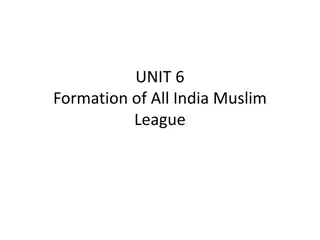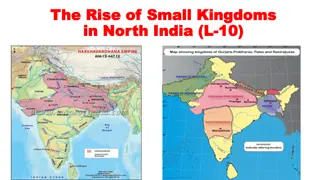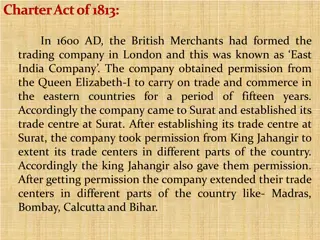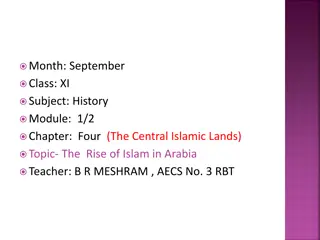Rise of Janapadas and Mahajanapadas in Vedic India
The rise of Janapadas and Mahajanapadas marked a significant transition in the political landscape of Vedic India. Janapadas, major kingdoms of that era, evolved into more powerful Mahajanapadas through territorial expansion and urbanization. The shift from tribal polities to territorial states led to the emergence of sixteen Mahajanapadas, with key characteristics including monarchy and republicanism. This transformation, evident in the later Vedic period, reshaped governance, administration, and societal structures in the Indian subcontinent.
Download Presentation

Please find below an Image/Link to download the presentation.
The content on the website is provided AS IS for your information and personal use only. It may not be sold, licensed, or shared on other websites without obtaining consent from the author. Download presentation by click this link. If you encounter any issues during the download, it is possible that the publisher has removed the file from their server.
E N D
Presentation Transcript
B.A.HISTORY(HONS) 1stSEMESTER UNIT 2
RISE OF JANAPADAS AND MAHAJANAPADAS- EXPANSION OF URBANISATION INTRODUCTION The Janapadas were the major kingdoms of Vedic India. By the 6th century B.C. there were approximately 22 different Janapadas. With the development of iron in parts of UP and Bihar, the Janapadas became more powerful and turned into Mahajanapadas. There were sixteen such Mahajanapadas during 600 B.C. to 325 B.C. in Indian Sub- continent. The Janapadas were the major kingdoms of Vedic India. By the 6th century B.C. there were approximately 22 different Janapadas.
The key points related to the Janapadas and the Mahajanapadas- The Janapadas were the major kingdoms of Vedic India. Aryans were the most influential tribes and were called as janas . This gave rise to the term Janapada where Jana means people and Pada means foot . By the 6th century B.C. there were approximately 22 different Janapadas. With the development of iron in parts of UP and Bihar, the Janapadas became more powerful and turned into Mahajanapads. In the sixth century BCE, there was a rise in the development of the Mahajanapada or great country. There were sixteen such Mahajanapadas during 600 B.C. to 325 B.C. in Indian Sub-continent. There were two types of states: Monarchical and Republican. Malla, Vajji, Kamboja and Kuru were Republican states while Magadha, Kosala, Vatsa, Aanti, Anga, Kashi, Gandhara, Shursena, Chedi and Matsya were monarchical in nature.
Janapadas to Mahajanapadas The Later Vedic period (900 600 BCE) witnessed the transition from a tribal polity based on lineage to a territorial state. The janas who migrated eastwards began to settle down in various regions. The loyalty of the people shifted from jana (tribe or clan) to janapada (territory). Janapada literally meant the place where the tribe sets its foot upon. The janapadas fought with one another for resources and political dominance. Some janapadas extended their territories and brought various janas within their jurisdiction. Such janapadas grew into mahajanapadas. Territory, people, government and sovereignty are important elements of a state. All these elements were found in some of the mahajanapadas. The mahajanapadas represented the emergence of territorial kingdoms that ruled over people (jana). The king headed the government aided by a centralised administration. The king was also the sovereign ruler. The king levied taxes out of agricultural surplus and redistributed it and ensured maintenance of law and order in a hierarchical society by force and coercion. These features marked the formation of state in the Gangetic plains.
Sixteen Mahajanapadas According to Puranic, Buddhist and Jaina traditions, there were sixteen mahajanapadas. Gandhara Kamboja Assaka Vatsa Avanti Shurasena Chedi Malla Kuru 10. Panchala 11. Matsya 12. Vajji (Vrijji) 13. Anga 14. Kasi 15. Kosala 16. Magadha The mahajanapadas are classified as gana-sanghas and chiefdoms based on the nature of their polity. 1. 2. 3. 4. 5. 6. 7. 8. 9.
Gana-Sanghas The proto-states of the Gangetic region were known as janapadas and comprised chiefdoms, republics and small kingdoms. Sixteen mahajanapadas find mention in the early texts. There were also ganasanghas or oligarchies, which were centred on clans. The Vrijjis were one of the best known of the gana-sanghas, and Vaishali was their capital in the Mithila region. These kingdoms did not come under the single decision-making authority of a king but decisions were taken on a collective basis by the heads of the different clans together. There were also smaller kingdoms such as Kosala and Kasi. It is interesting to note that the names of the clans, such as Ikshvaku and Vrishni, as well as these early kingdoms, are all mentioned in the two epics, Ramayana and Mahabharata.
Monarchies or Kingdoms The mahajanapadas on the Gangetic plains were all monarchies. Vedic orthodoxy was an established practice in these kingdoms. The priestly class enjoyed a preeminent status in the mahajanapadas unlike in the gana-sanghas. The kingdoms were governed by kings and the administration was centralised. The brahman priests provided legitimacy to the king through various rituals. The kingship was hereditary and the succession was in most cases based on the law of primogeniture. The king was assisted by councils called parishad and sabha. The councils were advisory in nature. The king appropriated the agricultural surplus through land revenue apart from a few other taxes. Bali was a tax imposed based on the area of cultivable land. Bhaga was obtained as a share of the produce. Kara and Shulka were some of the other taxes collected during this period. Thus the king raised revenue through taxes to maintain an elaborate administrative structure and an army. The richer landowners were called grihapatis. These landowners employed labourers called dasas or karmakaras. The smaller landowners were known as kassakas or krishakas. The society was stratified on the basis of varna. It emerged as a marker of status. Cultivators and artisans were identified as the shudras. A new social category that emerged during this period was placed below the shudras in the social hierarchy and considered untouchables. They were forced to live on the fringes of the settlements and subsisted on hunting and gathering their food. They were marginalised and given only menial jobs as urbanisation was on the rise. They had their own language, which was different from that spoken by the Indo-Aryans.
Mahajanapadas and Second Urbanization Agriculture improved during this phase of development in the middle Gangetic plains. Wet rice cultivation began to yield more produce of rice than other crops, thus creating the necessary agrarian surplus. Protected irrigation alone was not responsible for the surplus production of rice. Iron technology also played a crucial role. Agricultural surplus, the growth of crafts and trade, and the growing population led to the emergence of towns in the Gangetic plains. This is called the second urbanisation in Indian history after the first urbanisation evident in the Harappan Civilization. Different types of towns came into being. Political and administrative centres such as Rajgriha, Shravasti, Kaushambi and Champa ,Centres of trade and commerce such as Ujjain and Taxila ,Holy centres such as Vaishali.
REFERENCES https://rishiupsc.com/ https://www.jagranjosh.com/ www.Britannica.com\ Wikipedia.com

















































